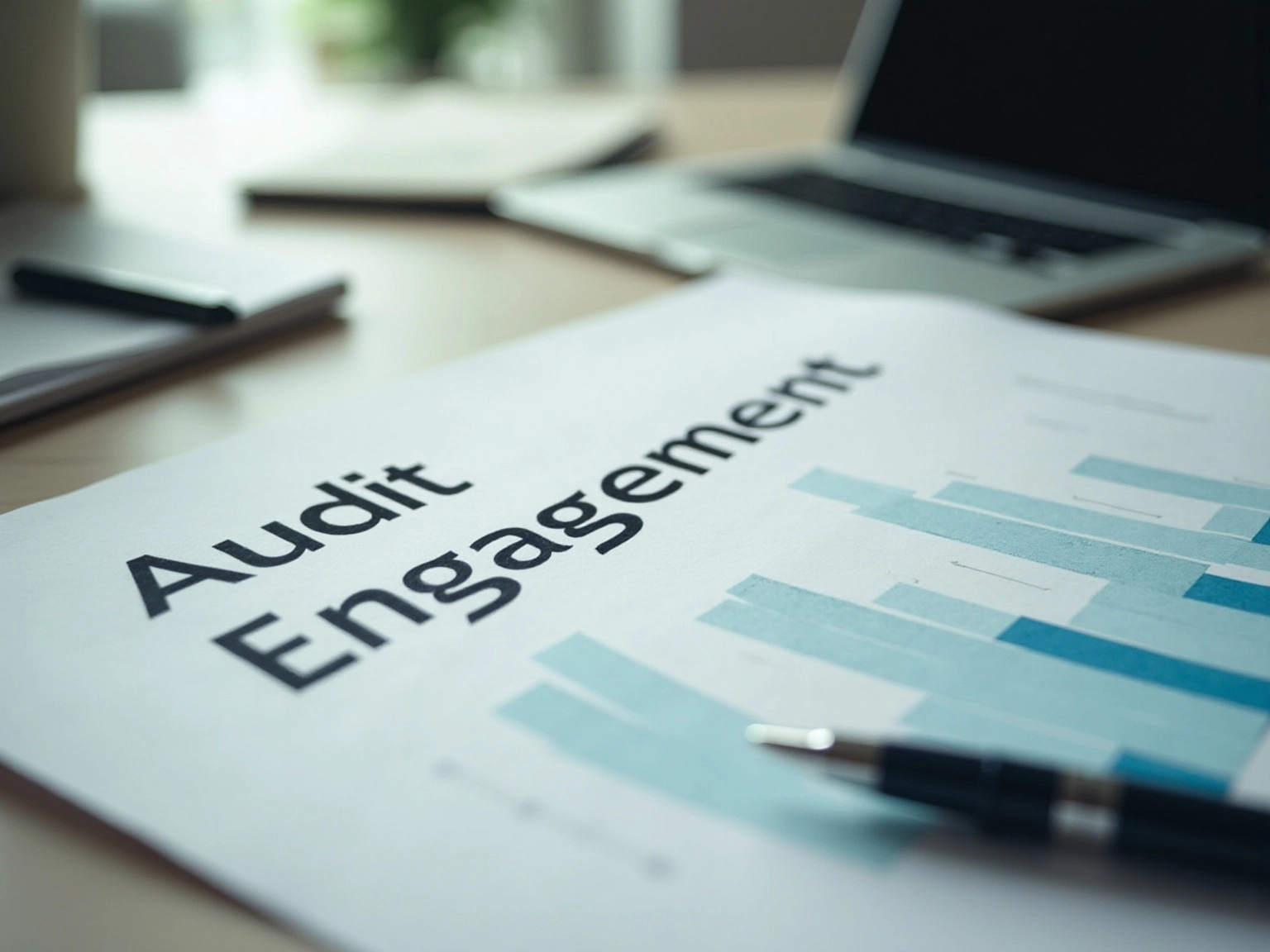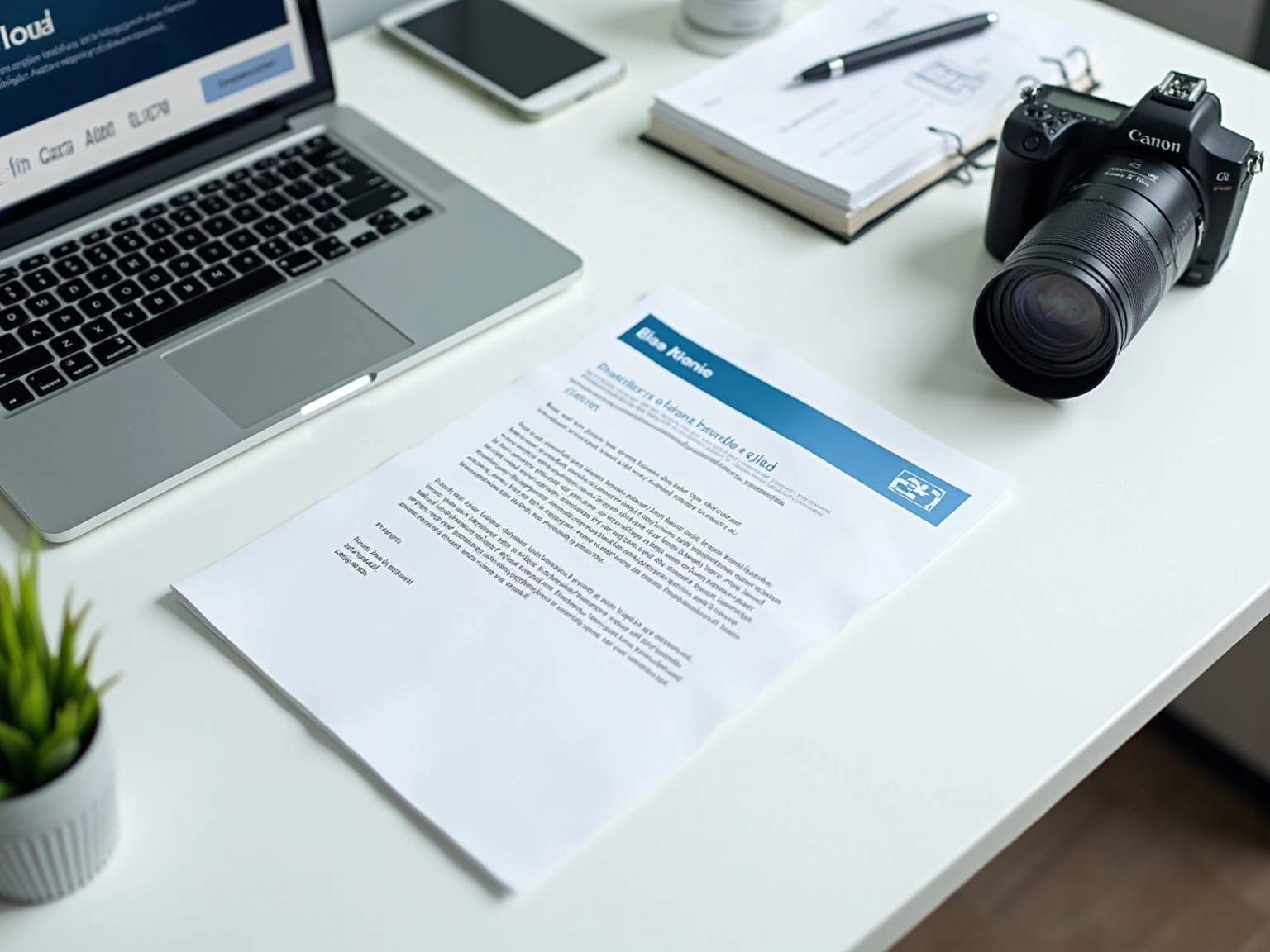Overview
This article serves as an essential guide to crafting an effective audit engagement letter, underscoring its critical role in delineating the scope, responsibilities, and expectations between auditors and clients. A well-structured engagement letter not only minimizes misunderstandings and legal disputes but also enhances communication through the integration of technology, such as Glasscubes. This approach streamlines the information-gathering process, ultimately leading to improved efficiency and heightened client satisfaction.
Key Highlights:
- An audit engagement letter is a formal agreement that defines the scope, responsibilities, and expectations between the auditor and the client.
- It aims to minimize misunderstandings and protect both parties, ensuring clarity in the audit process.
- Key components of an audit engagement letter include identification of parties, scope of the audit, objectives, responsibilities, timeline, fees, confidentiality, and signatures.
- The letter serves as legal protection and promotes clear communication, reducing the risk of disputes and fostering better relationships.
- Incorporating technology like Glasscubes can streamline workflows, enhance client satisfaction, and improve response times significantly.
- Common mistakes in drafting engagement letters include vagueness, omitting key components, neglecting legal compliance, and failing to update regularly.
- Automated reminders and real-time reporting features of technology platforms aid in efficient information gathering and management during the audit process.
- Regular updates to the engagement letter are essential to reflect any changes in circumstances or regulations.
Introduction
In the intricate world of auditing, the audit engagement letter serves as a cornerstone of clarity and accountability, defining the relationship between auditor and client. This essential document outlines not only the scope and responsibilities of the audit but also acts as a legal safeguard against potential disputes. As organisations navigate increasingly complex regulatory landscapes, the significance of a well-crafted engagement letter becomes even more pronounced.
With technology playing a pivotal role in streamlining communication and enhancing efficiency, understanding the components and best practices for these letters is vital for successful audit engagements. As firms look toward 2025 and beyond, the integration of innovative tools promises to transform the audit process, ensuring that both auditors and clients remain aligned and informed every step of the way.
Understanding the Audit Engagement Letter: Definition and Purpose
An audit engagement letter stands as a pivotal official document, delineating the terms of collaboration between the auditor and the client. This document functions as a binding agreement, explicitly defining the scope of the examination, the responsibilities of both parties, and the expectations for the evaluation process. Its primary objective is to ensure clarity and mutual understanding within the audit engagement letter, thereby minimising the potential for misinterpretations that may arise during the audit.
Establishing a distinct framework through the audit engagement letter is vital for protecting both the auditor and the client. It ensures that all parties are aligned on the objectives and outcomes of the audit, a factor of considerable importance given that 30% of respondents in recent surveys indicated that their acceptance of assignments with low-risk individuals is significantly influenced by risk evaluation factors. This statistic underscores the necessity of a clearly articulated audit engagement letter to mitigate risks associated with client acceptance.
In the UK, a substantial number of auditors utilise such agreements, reflecting their significance within the profession. The audit engagement letter not only serves as a safeguard against potential disputes but also enhances the overall client-auditor relationship. Practical examples illustrate that well-structured agreements can promote better communication and trust, ultimately resulting in a more effective review process.
For instance, Sophie Montgomery from TaxAssist Accountants reported an impressive 288 hours saved in a single tax season, highlighting the efficiency improvements achievable through effective communication facilitated by participation documents.
As we approach 2025, the importance of the audit engagement letter and other audit-related participation documents continues to grow, with expert insights emphasising their role in establishing clear expectations and fostering transparency. By ensuring that both reviewers and clients share a common understanding of the examination’s scope and objectives, the audit engagement letter is instrumental in the success of review assignments. Furthermore, technology solutions such as Glasscubes streamline workflows and enhance client satisfaction, further supporting the review process.
Glasscubes provides automated reminders and a real-time visual progress report, ensuring that all correspondence is centralised within each audit request. This significantly reduces the time spent searching for information. The case study on risk management in non-Big 4 public accounting firms also presents empirical evidence on factors influencing acceptance decisions, highlighting the critical nature of clear agreements. Overall, the integration of these elements emphasises the essential role of correspondence in the auditing field while demonstrating how Glasscubes can transform user interaction and simplify information collection.

Key Components of an Audit Engagement Letter: What to Include
When preparing an engagement letter for the examination, it is essential to include the following key components to ensure clarity and compliance:
- Identification of Parties: Clearly state the names and addresses of both the auditor and the customer to establish a formal agreement.
- Scope of the Audit: Define the specific areas and financial statements that will be audited, ensuring all parties understand the extent of the engagement.
- Objectives of the Review: Outline the purpose of the review, including any specific goals that guide the review process, which helps in aligning expectations.
- Responsibilities: Detail the responsibilities of both the auditor and the client, specifying what information the client must provide. This clarity helps prevent misunderstandings and ensures a smooth workflow.
- Timeline: Specify the expected timeline for the evaluation process, including key milestones. A well-defined timeline enhances accountability and keeps the engagement on track.
- Fees and Payment Terms: Clearly outline the fee structure and payment terms for the assessment services. Transparency in financial matters fosters trust between the auditor and the client.
- Confidentiality Clause: Include a statement regarding the confidentiality of the information shared during the audit. This is essential for protecting sensitive data and maintaining customer trust.
Signatures: Provide space for both parties to sign, indicating their agreement to the terms outlined in the document. This formalises the involvement and ensures that both parties are dedicated to the agreed-upon terms.
In 2025, these components remain essential for effective review processes, as they not only facilitate compliance with regulatory standards but also enhance communication between auditors and clients. For instance, selecting the appropriate report types within the audit engagement letter can significantly improve transparency and decision-making, ensuring that stakeholder expectations are met. Moreover, companies employing innovative tools such as Glasscubes have noted a 50% decrease in response times and a 38% rise in response rates, highlighting the significance of effective information collection in the evaluation process.
Automated reminders and real-time visibility offered by Glasscubes ensure that responses cannot get misplaced, promoting confidence in the review process. Glasscubes also addresses common challenges faced by accountants, such as duplicated requests and lack of visibility, by keeping all correspondence contained within each evaluation request. Sophie Montgomery from TaxAssist Accountants noted that her firm saved an impressive 288 hours in just one tax season, demonstrating the tangible benefits of adopting such technologies.
As auditors progressively adjust to new technologies and automation tools, incorporating these key elements in contracts will be crucial for successful remote examinations.
The Importance of an Audit Engagement Letter: Protecting Interests and Clarifying Expectations
The audit engagement letter serves as a cornerstone in the auditing process for several critical reasons:
-
Legal Protection: This document provides a vital legal safeguard for both the auditor and the client, ensuring protection in the event of disputes concerning the scope of work or responsibilities. Notably, statistics reveal that a substantial percentage of legal disputes in the auditing sector arise from ambiguities in contracts, highlighting their role in mitigating potential conflicts.
-
Clarity of Expectations: By explicitly outlining the roles and responsibilities of both parties, the audit engagement letter significantly reduces the risk of misunderstandings throughout the audit process. Clear expectations are essential; expert opinions indicate that clarity in communications can dramatically lower the likelihood of disputes, fostering a more collaborative environment. Furthermore, firms that have embraced clear communication practices, such as those facilitated by Glasscubes, have witnessed a remarkable 50% reduction in response times, demonstrating the efficiency gains achievable through clarity. Glasscubes enhances this process by providing automated reminders and a structured list of pending requests, ensuring that no information is misplaced or overlooked. In contrast to traditional email communication, which can result in duplicated requests and unclear visibility of responses, Glasscubes streamlines the process, rendering it more efficient.
-
Compliance with Professional Standards: Regulatory bodies mandate that auditors furnish an audit engagement letter as documentation to ensure adherence to professional standards. This requirement not only bolsters the credibility of the review but also reinforces the auditor’s commitment to ethical practices.
-
Foundation for Communication: The audit engagement letter establishes an official communication pathway between the auditor and the client, promoting seamless interactions during the review. This structured approach is crucial for maintaining transparency and ensuring that both parties are aligned on expectations and deliverables. With Glasscubes, all correspondence related to each review request is centralised, facilitating efficient communication and minimising the time spent searching for information. Additionally, Glasscubes is secure, encrypted, and GDPR compliant, providing peace of mind for both the firm and its clients.
As we approach 2025, the emphasis on clarity in the audit engagement letter remains crucial, as firms increasingly acknowledge the legal protections this document affords. Case studies indicate that individuals sharing the same auditor frequently converge on similar disclosure issues over time, underscoring the potential costs associated with ambiguous letters of agreement. For instance, the study titled ‘Auditor Style and Common Disclosure Issues’ reveals that auditor style can propagate decision errors among clients, further accentuating the necessity for clarity.
By prioritising clarity and legal protection within review processes, firms can substantially enhance their operational efficiency and customer satisfaction. As noted by Sophie Montgomery of TaxAssist Accountants, firms can save significant time—reporting an impressive 288 hours saved in just one tax season—by implementing clear communication documents and utilising tools like Glasscubes for dedicated onboarding support, ultimately improving information collection and involvement.

Defining Responsibilities: Auditor and Client Roles in the Engagement Letter
In the audit engagement letter, outlining the responsibilities of both the examiner and the customer is essential to guarantee a smooth and effective review process.
- Examiner Responsibilities: The examiner is tasked with executing the review in accordance with applicable reviewing standards, which include adhering to the guidelines set forth by the American Institute of Certified Public Accountants (AICPA). This involves providing an independent assessment of the financial statements and ensuring that all required review procedures are meticulously followed. Auditors must also evaluate management’s assessment of the entity’s capacity to persist as a going concern, reporting key insights that may influence the financial well-being of the organisation.
- Responsibilities of the Entity: The entity plays a crucial role in the examination process by granting access to all pertinent financial documents and collaborating fully with the auditor. It is vital that the information provided is accurate and complete to facilitate a thorough examination. Furthermore, the customer should appoint a specific liaison to enhance communication throughout the review, significantly improving process efficiency. Statistics indicate that firms utilising structured communication methods, such as those facilitated by Glasscubes, have experienced a 50% reduction in response times and a 38% increase in response rates, underscoring the importance of clear client interaction. Glasscubes’ automated reminders and real-time visibility features ensure that no requests are overlooked, enabling a more organised and efficient review process. Additionally, Glasscubes addresses the limitations of traditional email communication, such as the risk of misplaced responses and the inability to enforce comprehensive replies, which can lead to delays and confusion.
The AICPA provides templates for audit engagement letters that outline these responsibilities, ensuring compliance and clarity. These templates, which include non-negotiable terms regarding management’s obligations in the audit engagement letter, cannot be altered, thus providing a standardised approach to defining roles in the evaluation process. Case studies illustrate that companies adhering to these guidelines not only meet compliance obligations but also foster successful communication of responsibilities, resulting in more efficient evaluations.
For instance, firms implementing these templates have reported significant time savings, with users like Sophie Montgomery from TaxAssist Accountants noting an impressive 288 hours saved in just one tax season. This emphasises the tangible advantages of structured communication and compliance with AICPA standards in the evaluation process, especially when supported by tools like Glasscubes.
Legal and Compliance Considerations: Ensuring Adherence to Standards
When drafting an engagement letter for examination, it is crucial to address several legal and compliance aspects to ensure adherence to regulatory standards and mitigate potential risks.
Regulatory Requirements: The engagement letter must align with the examination standards and regulations established by authoritative bodies such as the Financial Reporting Council (FRC) and the Public Company Accounting Oversight Board (PCAOB). Adhering to these standards is not just a legal requirement but also a best practice that enhances the credibility of the review process.
Liability Limitations: Including clauses that limit the auditor’s liability under specific circumstances can be advantageous. However, these limitations must be crafted carefully to ensure compliance with legal standards and to uphold the auditor’s responsibilities. This approach safeguards auditors from excessive claims while maintaining accountability.
Dispute Resolution: It is essential to outline clear procedures for resolving disputes that may arise during the examination process. This can involve mediation or arbitration options, offering a structured method for conflict resolution, thereby minimizing disruptions to the review timeline.
In the realm of legal compliance, recent statistics reveal that 54% of organisations have faced a cyberattack in the past year, underscoring the importance of robust legal frameworks in review processes. Furthermore, the introduction of the Business Risk Reviews (BRR+) process in October 2019 has resulted in a 67% increase in assessments, with over 90% of large business customers engaging in compliance discussions. This proactive approach emphasises the necessity for audit engagement letters to reflect current compliance expectations and risk management strategies.
Moreover, integrating technology such as Glasscubes can significantly enhance the efficiency of the review process. With its automated features providing real-time visibility into request statuses, accounting firms can manage customer information more effectively. Automated reminders and organised responses ensure that no information is misplaced, and all correspondence is included within each request.
As noted by Sophie Montgomery of TaxAssist Accountants, firms utilising such tools have reported impressive time savings, with one firm saving 288 hours in just one tax season. Additionally, it is essential for accounting professionals to stay updated on evolving regulatory landscapes, as 77% of risk professionals find it important to keep abreast of ESG developments. By incorporating these components into assessment documents, along with the efficient communication and real-time monitoring features of Glasscubes, accounting firms can improve their legal adherence and build trust with customers, ultimately resulting in more successful evaluation interactions.

Crafting the Audit Engagement Letter: A Step-by-Step Approach
To create an effective engagement document, follow these organised steps:
-
Gather Information: Start by collecting comprehensive details about the customer, including their business structure, financial statements, and specific examination requirements. This foundational step ensures that the document is tailored to the client’s unique context.
-
Draft the Audit Engagement Letter: Begin drafting the audit engagement letter by incorporating essential components such as the scope of the audit, responsibilities of both parties, and any specific industry regulations that may apply. Utilise clear and concise language to eliminate ambiguity, thereby enhancing the document’s effectiveness.
-
Review for Compliance: Rigorously verify that the document adheres to all relevant legal and regulatory standards. Given the complexities of different industries, such as healthcare and banking, consulting with legal counsel may be beneficial to ensure all necessary requirements are met. As noted by Maggie Cheney, an expert in Risk Management and IT Compliance, understanding these complexities is crucial for effective compliance.
-
Send for Approval: Forward the draft letter to the customer for their review and approval. Encourage open communication, allowing customers to provide feedback or request modifications. This fosters a collaborative relationship and reduces the risk of misunderstandings. Utilising Glasscubes’ automated reminder feature can significantly enhance this process by sending timely reminders for responses, ensuring that no communication is overlooked. With Glasscubes, you can send an unlimited number of reminders on a customisable schedule, tailoring messages to indicate urgency and specific deadlines.
-
Finalise and Sign: After reaching an agreement on the content, complete the document and secure signatures from authorised representatives of both the auditor and the client. This step solidifies the involvement and ensures that both parties are aligned on the scope and expectations of the assessment.
Incorporating industry-specific requirements into assessment agreements not only enhances clarity but also improves the overall effectiveness of the evaluation process. Certain sectors have particular regulations that must be included in the audit engagement letter to ensure compliance and minimise misunderstandings. Tools like Glasscubes can further streamline this process by automating the creation and management of audit engagement letters, significantly reducing the time taken to draft them and improving accuracy.
Glasscubes is secure, encrypted, and GDPR compliant, offering peace of mind for your business and customers. Firms utilising such tools have reported a 50% reduction in response times and a 40% boost in client interaction, showcasing the efficiency gains achievable through modern technology. As emphasised by Wolters Kluwer Tax & Accounting, a review checklist serves as a guide that guarantees the completion of all necessary steps and facilitates the automation of repetitive tasks.

Common Mistakes to Avoid: Enhancing the Effectiveness of Your Engagement Letter
When drafting an audit engagement letter, it is essential to avoid several common pitfalls that can undermine the effectiveness of the document:
-
Vagueness: Avoid ambiguous language that may lead to misunderstandings. Clearly define the scope of the examination and the responsibilities of both parties to ensure mutual understanding. Glasscubes enhances clarity by providing organised communication, ensuring that all requests and responses are neatly archived and easily accessible. This organised method assists in avoiding ambiguity in the agreement. As James Ashford, Founder of GoProposal, notes, “What you end up with is an overcomplicated document fulfilling the robustness you need to have, but it’s failing on clarity.”
-
Omitting Key Components: The audit engagement letter must include all essential elements in the document, such as the objectives of the evaluation, the timeline, and the fees involved. Glasscubes’ real-time visibility into audit processes ensures that all necessary information is captured and communicated effectively, reducing the risk of omissions that can complicate the involvement.
-
Neglecting Legal Compliance: Adherence to legal and regulatory requirements is non-negotiable. Glasscubes supports compliance by automating reminders for necessary documentation and updates, ensuring that the engagement agreement meets all required standards. Failing to comply with the audit engagement letter can lead to significant consequences, so always perform a thorough review of the document to ensure it meets all necessary standards.
-
Not Updating Regularly: The audit engagement letter should not be static; engagement documents must be updated regularly. Regular evaluations and updates are crucial to reflect any changes in the assessment process or the client’s circumstances. Glasscubes facilitates this by providing automated workflows that prompt timely updates, ensuring that the document remains relevant and effective.
Integrating these best practices can substantially improve the clarity and efficiency of review communications outlined in the audit engagement letter, ultimately resulting in better assessment results. For instance, companies that have embraced organised methods for creating engagement letters have observed a significant rise in customer satisfaction and adherence to review standards. By prioritising clarity and thoroughness, accountants can mitigate risks associated with vague language and omissions, fostering a more productive review process.
Additionally, tools such as Glasscubes, which enhance communication and offer real-time insight into review processes, have resulted in a 50% decrease in customer response times. This highlights the significance of transparent communication in the review process, improving overall efficiency and customer involvement.

Leveraging Technology: Streamlining Information Gathering for Audit Engagement Letters
To enhance the efficiency of gathering information for audit engagement letters, leveraging technology such as Glasscubes can be transformative:
-
Centralised Communication: Implementing platforms like Glasscubes that centralise interactions with customers simplifies the process of collecting necessary information and documents. This approach mitigates the risk of material misstatements by ensuring that all communications are organised and easily accessible. With Glasscubes, the confusion of endless email threads is removed, facilitating structured communication that improves clarity and minimises the chances of misplaced information.
-
Automated Reminders: Utilising automated reminders through Glasscubes can significantly reduce the time accountants spend following up with customers for required information. This feature not only streamlines the process but also boosts response rates, as evidenced by firms that have adopted Glasscubes, which reported a 40% increase in replies. Notably, users like Sophie Montgomery of TaxAssist Accountants have reported impressive time savings, with some firms saving as much as 288 hours in just one tax season.
-
Real-Time Reporting: Tools that offer real-time visibility into the status of information requests, such as those provided by Glasscubes, allow accounting teams to track and manage responses more effectively. This capability is crucial for maintaining workflow efficiency, as it enables accountants to prioritise tasks based on the urgency of customer needs, ensuring that everyone is on the same page throughout the evaluation process.
-
Secure Document Sharing: It is essential to use a platform that ensures secure and GDPR-compliant document sharing. Glasscubes offers a secure setting for sharing sensitive client information, tackling typical worries regarding data protection while promoting effective communication.
Integrating these technological solutions not only simplifies the review letter process but also improves overall efficiency. For example, a case study on the use of Glasscubes in technology application in review processes highlighted that integrating technology support teams with auditors can significantly enhance usability and increase technology adoption within firms. This customised approach is essential for nurturing a culture that embraces innovation.
Moreover, the advancements in Computer-Assisted Review Techniques (CAATs) have made technology an integral part of modern practices. By adopting these tools, including Glasscubes, accounting firms can ensure that they are not only keeping pace with industry standards but also enhancing their operational effectiveness. As noted by industry professionals, the strategic use of technology in audit engagements can lead to substantial time savings, underscoring the importance of embracing technology to optimise workflows and improve client satisfaction.
Conclusion
The audit engagement letter stands as a pivotal element in ensuring successful audit processes, serving as a formal agreement that distinctly defines the relationship and expectations between auditors and clients. By outlining key components such as the scope of the audit, responsibilities, and timelines, these letters minimize misunderstandings and provide essential legal protections for both parties. Furthermore, the integration of innovative technologies, such as Glasscubes, significantly enhances communication efficiency and streamlines information gathering, ultimately conserving valuable time and resources.
As the auditing landscape continues to evolve, the significance of a well-structured engagement letter cannot be overstated. It not only fosters transparency and accountability but also aligns expectations, thereby contributing to a more collaborative and efficient audit process. By adhering to best practices and leveraging technological solutions, firms can markedly improve their operational efficiency, ensuring compliance with professional standards while cultivating stronger relationships with clients.
Looking ahead to 2025 and beyond, the emphasis on clarity, legal protection, and effective communication will remain paramount in audit engagements. By prioritising these elements and embracing advancements in technology, auditors can adeptly navigate the complexities of the regulatory environment while enhancing client satisfaction and trust. A proactive approach to crafting and managing audit engagement letters will undoubtedly lead to more successful and productive audit outcomes.
